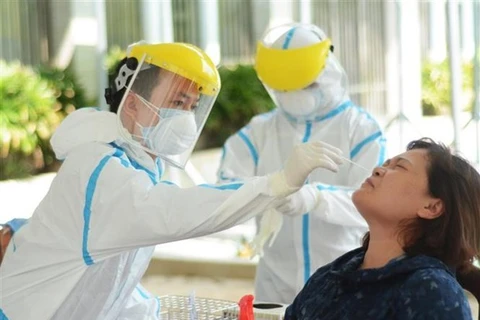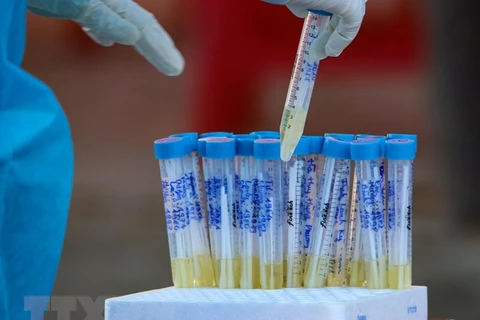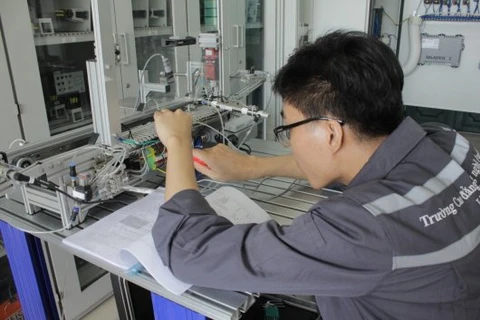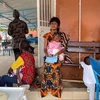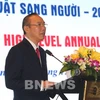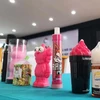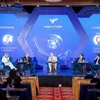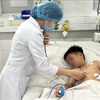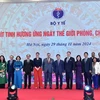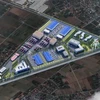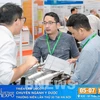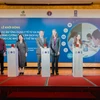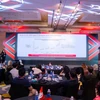Hanoi (VNS/VNA) - The flexible and creative application of a strategy to prevent, detect, isolate, zone and control COVID-19 had played a decisive role in Vietnam’s successful battle against the pandemic, experts have said.
"This has been an important strategy and contributed to the success of disease prevention and control," said Associate Professor Tran Nhu Duong, deputy head of the National Institute of Hygiene and Epidemic, adding that the strategy had been consistently applied since the start of the pandemic.
“When a COVID-19 case is detected in the community, the first thing to do right away is to track all the people who have had contact with the patient and quarantine them.
“Those who have had close contact with the patient, known as F1, are people at high risk of being infected and can become a source of infection in the community,” he said at a recent national teleconference to review the fight against the pandemic.
Tracing F1s as soon as a case is detected is a key part of disease containment because there is a very small window in which to track and quarantine contacts before they become infectious.
The incubation period between contact with the virus and start of symptoms might be just 1-2 days or up to 14 days. Therefore, it was critical to trace and locate contacts as soon as possible before they could potentially infect others, Duong said.
He also said that the identification of suspected cases should be based on epidemiological risk of infection.
Experience during the battle against COVID-19 in Da Nang showed that many patients had travelled to different places, mainly Ho Chi Minh City, Quang Ngai and Quang Nam. Competent agencies collaborated with those localities to track F1s.
“That approach has made tracing speedy and comprehensive. Without collaboration with other COVID-19 response teams, it would take a team a few days or even weeks to complete F1 tracing,” Duong said.
He said it was essential to be proactive and quickly make use of the "golden time" after a case is detected to take samples for testing and quarantine suspected cases to reduce the spread of the disease.
“All F1 cases must be isolated at centralised quarantined centres and not at home because any negligence from them could leave a loophole in the disease prevention system”, Duong said.
He cited Da Nang as a typical example.
The city's authorities mobilised resources to quarantine 11,621 F1 cases, and 121 positive cases were detected among them.
Regarding the city's zoning strategy, every day epidemiological groups from the Government and locality analysed epidemiological data, and pointed out complicated epidemic outbreaks. Then they advised local authorities to promptly zone off certain areas.
The city identified more than 60 hotspots and zoned them off during the one-month battle with the pandemic.
This strategy was flexible, easy to implement and helped to prevent the pandemic while ensuring social security, Duong said.
Sharing experience on disease prevention and control, Ngo Thi Kim Yen, Director of Da Nang's Health Department, said when the first community transmission cases of coronavirus were confirmed, the city mobilised all its forces to assess the threat and implemented measures to deal with the disease.
On July 26, Da Nang Hospital was placed under lockdown and soon after that two adjacent hospitals were closed.
Two days later, the city decided to impose social distancing to stop the spread of the virus.
Thanks to the adoption of drastic measures, the disease was quickly controlled, she said.
No community infections had been detected in the city for the past 38 days, Yen said, adding that the city had applied the strategy of “prevent, detect, isolate, zone and control”.
The strategy also proved to be effective in HCM City.
Nguyen Tan Binh, Director of HCM City's Health Department, said with the direction of the political system and a joint consensus among local residents, the disease was basically under control.
The city has recorded no community cases for 63 days.
Binh attributed the result to the implementation of anti-disease plans, especially closely monitoring people coming from other countries, territories, cities and provinces.
One of the main factors contributing to Vietnam’s success in the fight against COVID-19 was the mobilisation of the community, Duong said.
In the spirit of "fighting the pandemic like fighting the enemy", thousands of COVID-19 response teams were set up across the country.
Da Nang has 2,200 teams while Quang Nam has 5,500, and Quang Ngai and Quang Tri have 2,300 and 4,434, respectively.
These teams were tasked with supervising and disseminating information on disease prevention and control for each household. They acted as a bridge connecting the Government, the health sector and the people.
“COVID-19 response teams within the community were part of the creative and unique response Vietnam adopted in the fight against the pandemic that few places in the world could replicate. This is the most vivid demonstration of people-based prevention, mobilising the entire population to stop the pandemic, ” Duong said./.
"This has been an important strategy and contributed to the success of disease prevention and control," said Associate Professor Tran Nhu Duong, deputy head of the National Institute of Hygiene and Epidemic, adding that the strategy had been consistently applied since the start of the pandemic.
“When a COVID-19 case is detected in the community, the first thing to do right away is to track all the people who have had contact with the patient and quarantine them.
“Those who have had close contact with the patient, known as F1, are people at high risk of being infected and can become a source of infection in the community,” he said at a recent national teleconference to review the fight against the pandemic.
Tracing F1s as soon as a case is detected is a key part of disease containment because there is a very small window in which to track and quarantine contacts before they become infectious.
The incubation period between contact with the virus and start of symptoms might be just 1-2 days or up to 14 days. Therefore, it was critical to trace and locate contacts as soon as possible before they could potentially infect others, Duong said.
He also said that the identification of suspected cases should be based on epidemiological risk of infection.
Experience during the battle against COVID-19 in Da Nang showed that many patients had travelled to different places, mainly Ho Chi Minh City, Quang Ngai and Quang Nam. Competent agencies collaborated with those localities to track F1s.
“That approach has made tracing speedy and comprehensive. Without collaboration with other COVID-19 response teams, it would take a team a few days or even weeks to complete F1 tracing,” Duong said.
He said it was essential to be proactive and quickly make use of the "golden time" after a case is detected to take samples for testing and quarantine suspected cases to reduce the spread of the disease.
“All F1 cases must be isolated at centralised quarantined centres and not at home because any negligence from them could leave a loophole in the disease prevention system”, Duong said.
He cited Da Nang as a typical example.
The city's authorities mobilised resources to quarantine 11,621 F1 cases, and 121 positive cases were detected among them.
Regarding the city's zoning strategy, every day epidemiological groups from the Government and locality analysed epidemiological data, and pointed out complicated epidemic outbreaks. Then they advised local authorities to promptly zone off certain areas.
The city identified more than 60 hotspots and zoned them off during the one-month battle with the pandemic.
This strategy was flexible, easy to implement and helped to prevent the pandemic while ensuring social security, Duong said.
Sharing experience on disease prevention and control, Ngo Thi Kim Yen, Director of Da Nang's Health Department, said when the first community transmission cases of coronavirus were confirmed, the city mobilised all its forces to assess the threat and implemented measures to deal with the disease.
On July 26, Da Nang Hospital was placed under lockdown and soon after that two adjacent hospitals were closed.
Two days later, the city decided to impose social distancing to stop the spread of the virus.
Thanks to the adoption of drastic measures, the disease was quickly controlled, she said.
No community infections had been detected in the city for the past 38 days, Yen said, adding that the city had applied the strategy of “prevent, detect, isolate, zone and control”.
The strategy also proved to be effective in HCM City.
Nguyen Tan Binh, Director of HCM City's Health Department, said with the direction of the political system and a joint consensus among local residents, the disease was basically under control.
The city has recorded no community cases for 63 days.
Binh attributed the result to the implementation of anti-disease plans, especially closely monitoring people coming from other countries, territories, cities and provinces.
One of the main factors contributing to Vietnam’s success in the fight against COVID-19 was the mobilisation of the community, Duong said.
In the spirit of "fighting the pandemic like fighting the enemy", thousands of COVID-19 response teams were set up across the country.
Da Nang has 2,200 teams while Quang Nam has 5,500, and Quang Ngai and Quang Tri have 2,300 and 4,434, respectively.
These teams were tasked with supervising and disseminating information on disease prevention and control for each household. They acted as a bridge connecting the Government, the health sector and the people.
“COVID-19 response teams within the community were part of the creative and unique response Vietnam adopted in the fight against the pandemic that few places in the world could replicate. This is the most vivid demonstration of people-based prevention, mobilising the entire population to stop the pandemic, ” Duong said./.
VNA

